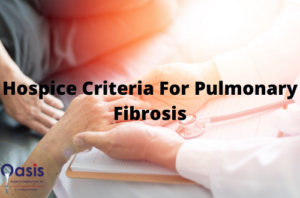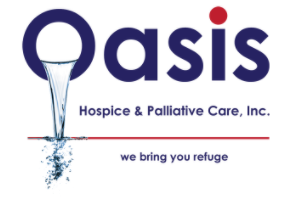Are you a patient, a caregiver, or a family member? Learn how Oasis Hospice can assist patients suffering from end-stage COPD and other types of lung disease.

Hospice eligibility criteria for COPD and lung disease are as follows:
Important Characteristics
- Dyspnea at rest and/or with light exertion while receiving oxygen therapy
- Dyspnea that is unresponsive or only partially responsive to bronchodilator therapy
- Chronic pulmonary disease progression as evidenced by one or more of the following:
- Frequent use of medical services, such as hospitalizations, ER visits, and/or physician outpatient visits, due to pulmonary disease symptoms
- Bronchitis or pneumonia regularly
- Unintentional weight loss of 10% of body weight in the previous six months
- Progressive inability to perform various activities of daily living (ADLs) independently or increasing reliance on ADLs, resulting in a progressively lower performance status
Other Critical Factors to Consider
- Pulmonary Cor
- Chronic continuous oxygen therapy
- >100 beats per minute at rest
- Steroid-dependent
- Cyanosis
- abnormal laboratory results
- FEV1 30% predicted post-bronchodilator
- FEV1 decreases by at least 40 mL/year over several years
- On room air, PO2 55
- On room air, O2 saturation was 88 per cent.
- PCO2 persistent hypercarbia (50 mm HG)
Oasis Hospice makes these guidelines available as a helpful tool. They are not intended to replace a physician’s professional judgment. What are the hospice criteria for pulmonary fibrosis?
End-Stage COPD and Other Types of Lung Disease Hospice Clinical Eligibility
Physicians may use clinical guidelines to identify patients in the final six months of lung disease. Patients should be physiologically and psychologically hospice-appropriate when it comes to end-of-life care.
Hospice care is intended to assist patients who:
- They’ve gotten to the point where they spend most of their days at home.
- Have had multiple ER visits (one or more per quarter) due to infection or episodes of respiratory failure
- Have had multiple hospitalizations (one or more per quarter) and no longer want to be admitted
- I don’t want to be intubated anymore.
- Oasis Hospice advises patients and their families on their goals and alternative methods of symptom management in order to avoid unnecessary hospitalization and intubation.
Nonmalignant, life-limiting chronic lung diseases are classified as follows:
- Chronic obstructive pulmonary disease (COPD) (COPD)
- Emphysema
- Bronchitis is chronic
- Chronic asthma
- Bronchiectasis
- Fibrosis of the lungs
- Cystic fibrosis (CF)
- End-stage tuberculosis
Hospice Care for Patients with End-Stage COPD and Other Lung Diseases
Dyspnea and the associated anxiety are two of the most distressing symptoms that patients experience. These are frequently treated with a combination of clinical therapies and the individual, 24-hour support provided by hospice. The Oasis Hospice end-of-life lung disease care plan includes the following components:
- A comprehensive evaluation by the entire interdisciplinary team
- Pre-emergency care planning is by the patient’s needs and goals
- Interventions, both pharmacologic and nonpharmacologic, to reduce episodes of respiratory distress
- A customized emergency protocol is used to provide a 24-hour response after the onset of respiratory distress.
- Caregiving goals centered on improving the patient’s quality of life.
Death From Pulmonary Fibrosis What to Expect
Thinking about death and dying can be upsetting, but you can make the process seem less daunting by sharing your feelings with friends and family. Hospice care is essential for your loved ones with pulmonary fibrosis.
Everyone is different, but your lung function is likely to decline over time, and you may require oxygen to support your breathing. As your pulmonary fibrosis progresses, you may experience increased fatigue and difficulty breathing.
Signs Of Death
As your lung function deteriorates, you will likely want to spend more time in bed. Toward the end, you may be sleepy or unconscious for long periods of time.
You may lose interest in eating and drinking as well. Your breathing pattern may change, causing your skin to become pale and moist and you to become extremely tired.
You might want to think about end-of-life care. Many patients find this extremely beneficial because it helps you manage your physical symptoms while also providing emotional support for you and your family. End-of-life care can be provided in various settings, including your home, a hospital, a care home or nursing home, and a hospice.
Care For The Dying
You and your family may need to make some practical changes if you choose to be cared for or die at home. You can have equipment installed in your homes, such as a ramp, stairlift, or oxygen. Pulmonary Fibrosis care provides grants as well as equipment.
You may also require specialized nursing assistance with toileting or eating. You can seek guidance from your palliative care team or a hospice.
Making Your Desires a Reality
Knowing that your family and friends have fulfilled your wishes can be very powerful. There are several documents in which you can express your wishes for end-of-life care and after death:
- A lasting power of attorney is a legal document in which you appoint one or more people (known as “attorneys”) to assist you in making decisions or to make decisions on your behalf once you are unable to do so on your own.
- An advanced care plan expresses your preferences for future care if you lose mental capacity. You might want to include details about where you want to die and who you want to accompany you.
- An advanced decision or living will is a legally binding document that expresses your preferences for future medical treatment, including whether you want to receive potentially life-sustaining treatment.
- Your will specifies who should inherit your property, money, and other assets. Don’t put it off if you haven’t already made a will or if you want to update an existing will. Make sure that your loved ones know where to look for it.
- A funeral plan can range from expressing your wishes about whether you want to be buried or cremated to the people, music, readings, and flowers present at your funeral.
Oasis Hospice provides the best care for pulmonary fibrosis. You can contact oasis hospice to get the best hospice services. We also share criteria for heart failure; you can check it out. For information, contact us at (708) 564-4838.

